BEST FOR FAMILIES
Cala Mitjana, Menorca
Menorca’s beaches are brilliant. The entire island was designated a Unesco biosphere reserve in 1993, and the natural tranquillity of the landscape has been carefully preserved in a sustainable approach to tourism that has helped keep the island unspoiled. Cala Mitjana is a ravishing Caribbean-style beach with fine white sand and turquoise water, but it can get busy in summer. If you are feeling energetic and looking for quieter beaches, continue south-east along the well-marked coastal trail for 20 minutes to the equally delectable Cala de Trebalúger.
Where to stay
Agroturismo-style Hort Sant Patrici (doubles from €200), 9km north of Mitjana, has a Menorcan-themed restaurant, vineyards, a cheese factory and pool.
Where to eat
Pizzeria Bobby, 8km north-east of Mitjana in Ferreríes, is a family-run restaurant serving stone-baked pizzas.
Playa de Temperáns, Costa Galicia South
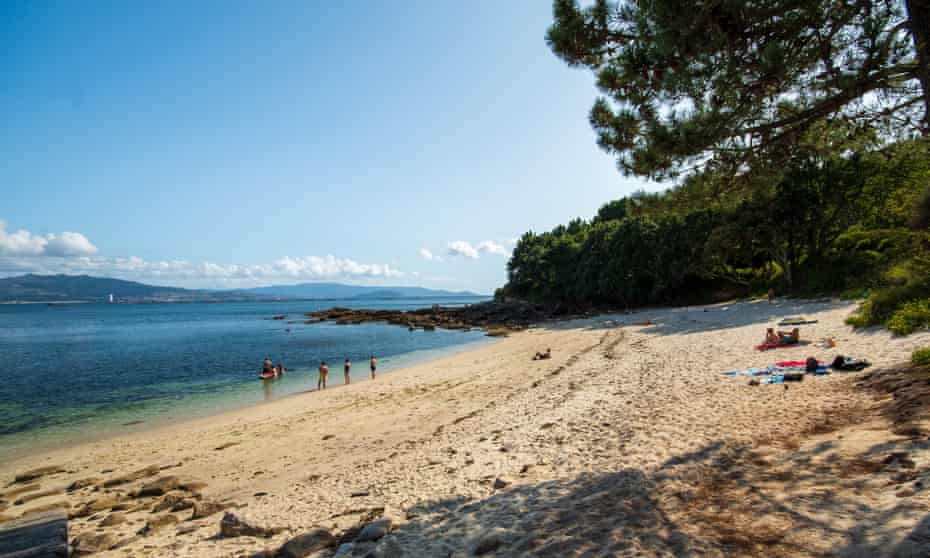
The Costa Galicia in the north-west of Spain boasts 1,500km of coastline and some of the most beautiful beaches in Europe. About 35km north of the city of Vigo (famous for its osyters) Praia de Temperáns, a seven-minute drive south-east of the village of Nerga, is a secluded and tranquil bay, perfect for family swimming and snorkelling. Park near Miradoiro do Bouceiro and follow the track around the house to the beach. The path leads on south-west to another secluded spot, Praia das Moscas.
Where to stay
Camping Limens (pitch from €33, bungalow from €65) is a short drive west of Temperáns and offers spacious pitches on terraces with views of the Ría de Vigo and the Cíes Islands. (Campsite prices are for a pitch for two in high season.)
Where to eat
Only 15 minutes’ drive from Praia de Temperáns is regional capital Cangas de Morrazo, bursting with ice-cream vendors and cafes. Vegetarians, vegans and children are well catered for: don’t miss the pimientos de padrón, savoury empanadas gallegas and torta de Santiago almond cake. Restaurant O Bruño serves local seafood dishes.
Playa de Dique, Costa Galicia north

The Costa Galicia north runs from the Pontevedra estuary, north of Vigo to Ría de Muros y Noya, 60km west of Santiago de Compostela. Playa de Dique is an enchanting sandy nook sheltered from the Atlantic winds between rocky headlands and pinewoods. The waves and swell are strong but a picturesque creek at the rear of the beach provides safe bathing and playing for children. The enclosed space and shallow stream make Praia do Dique the perfect place for families to settle for the day. It’s best to park near the entrance to Castro de Baroña, take the path towards Praia de Arealonga, walk south to the end of the beach and over the headland, then follow waymarkers for 400 metres to Praia do Dique.
Where to stay and eat
Camping Rianxo (pitch from €34.50, double bungalow from €40, hostel from €10pp) is a grassy campsite and bar half an hour from do Dique, with delicious food, especially the freshly caught xoubas (sardines) and locally grown padrón peppers. Nearby Turnauga Turismo e Aventura offers white-water rafting, kayaking and cliff jumping.
Playa de Mónsul, Costa Almería
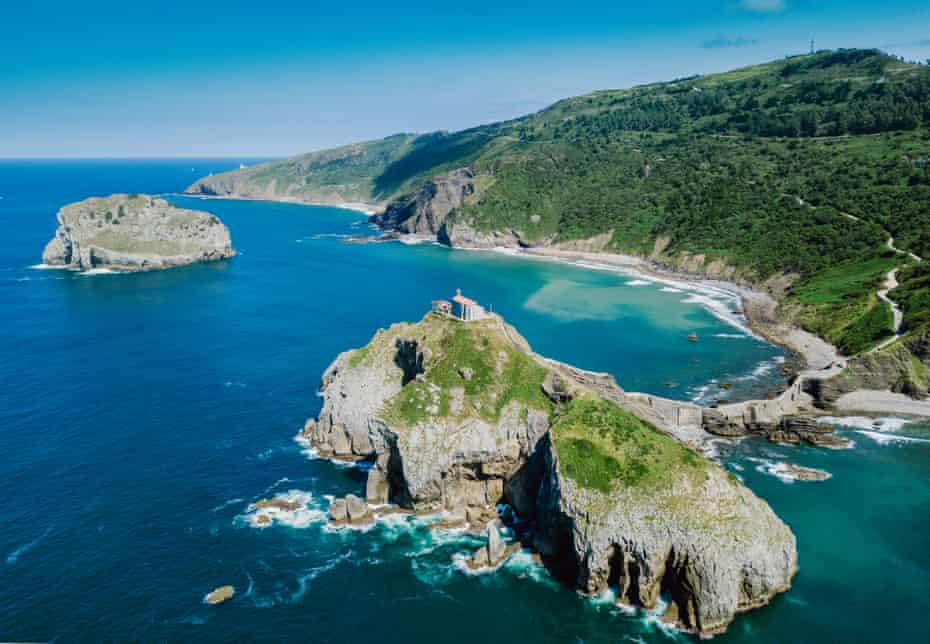
The arid semi-desert province of Almería has provided the backdrop to a huge number of films, particularly westerns. On three remaining film sets, for a fistful of euros you can watch wild west re-enactments and wander around the original locations at Spain’s mini-Hollywood. The south-west of Almería has a wild coastline where cactus-strewn paths in the Cabo de Gata natural park lead to remote sandy beaches. At triple-coved Playa de Mónsul, 5km south-west of San José, fossilised lava has formed vast overfilled volcanic muffins, and a dramatic rock rears from the sand at the water’s edge like a tremendous sea creature. No wonder Steven Spielberg chose Mónsul as a location for Indiana Jones and the Last Crusade, the scene where Henry Jones Senior (Sean Connery) uses an umbrella to flush a flock of birds into the sky to bring down a Nazi plane. It has no services, but a colossal sand dune provides the stage for children’s swashbuckling adventures.
Where to stay
Camping Cabo de Gata (pitch from €32.50), 30 minutes’ drive from Mónsul, is a great campsite with play area, superb pool and friendly staff.
Where to eat
Restaurante Casa Pepe in San José has great views with tapas to match and is popular with locals as well as tourists.
Caló es Caragol, Mallorca
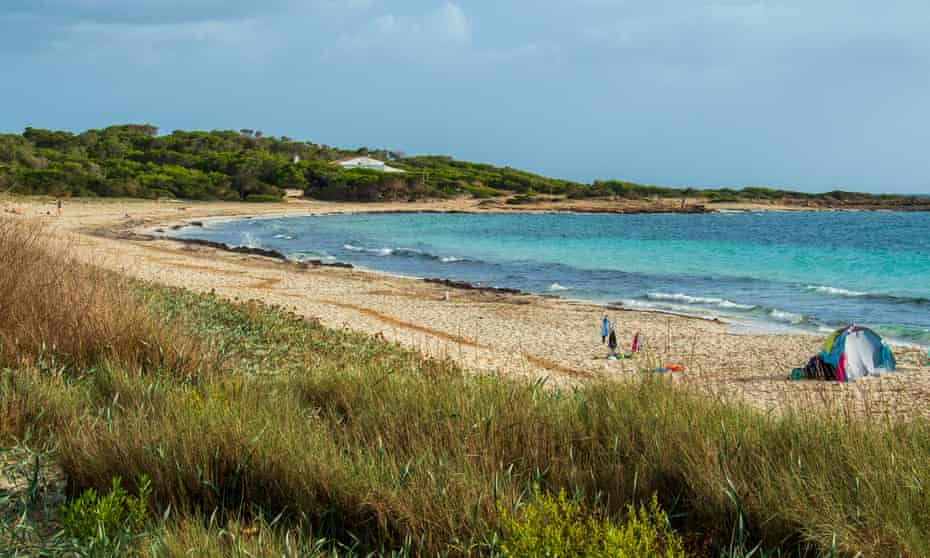
The impressive peaks of Mallorca’s Serra Tramuntana give way to vineyards and orchards, and its the clear blue waters support rich and diverse marine life. Sandy Caló es Caragol is in a remote and unspoiled bay on the southernmost tip of the island, where butterflies flit around the dunes. Driving from Es Llombards you’ll pass Faro de Cap Salines, the first solar powered lighthouse in Spain. The beach itself is a half-hour walk north-west from here along the path to the right of the fence towards the sea, then round the headland on the right. Shallow water and an abundance of space makes it perfect for family beach games and slow-paced days. No services for miles around.
Where to stay
Agroturism Possessió Binicomprat (doubles from €160 B&B), 45 minutes’ drive north of Caragol, is a rural hotel surrounded by vineyards, oak forests and aromatic plants. Sumptuous breakfasts are served in the garden.
Where to eat
Restaurant Molí de Sal, 20 minutes’ drive north, serves fresh Mallorcan specialities accompanied by homemade bread, dips, native olive oil, original sea salt and olives.
BEST FOR LONG WALKS
Playa Arnela, Costa Da Morte, Galicia
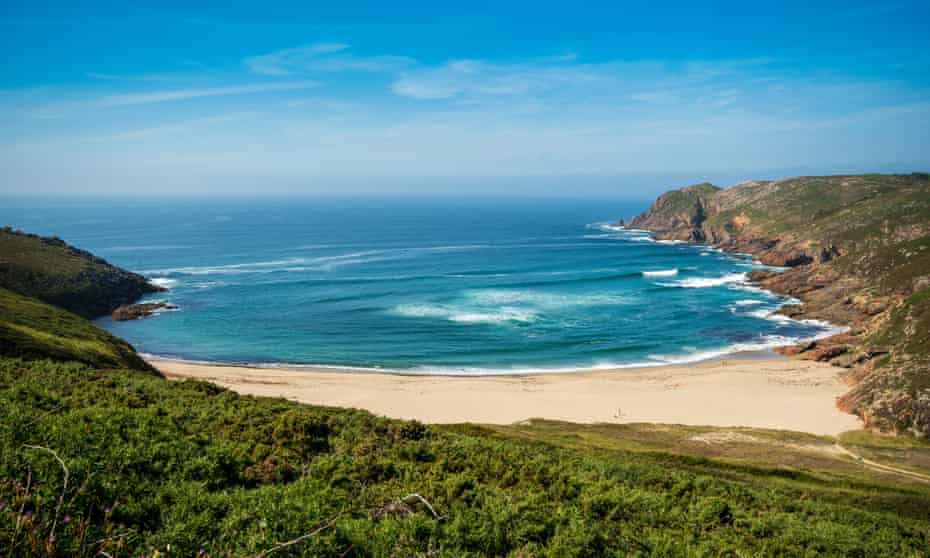
The Camino dos Faros or Lighthouse Way is a 200km coastal hiking trail in Galicia that links Malpica with Fisterra, taking in the wild beauty of the Costa da Morte. The Faro de Fisterra lighthouse is on the spot that, in Roman times, was thought to be the edge of the world. A few kilometres north lies Playa Arnela, amid unbridled countryside of bucolic villages and fields of maize. Ferocious waves pound the shore and riptides are clearly visible. It’s a place to feel isolated from the world and marvel at the sheer power of the Atlantic.
Where to stay and eat
Laid-back rural campsite Camping Playa Barreira Leis (pitch from €33) half an hour’s drive north from Arnela has spacious terraced pitches and an exceptional bar serving home-cooked, locally sourced food.
San Juan de Gaztelugatxe, Basque country

The rugged Basque coast (Costa Vasca) starts at Castro Urdiales just west of Bilbao and continues up to the border with France, near the foothills of the Pyrenees. At its midway point we discovered the islet of Gaztelugatxe, the incredible location for Dragonstone Castle in Game of Thrones. At its summit sits the Hermitage of San Juan, accessed from the mainland across an ancient bridge and 241 steps. From here, it’s easy to imagine swooping dragons and Daenerys Targaryen plotting to rule the Seven Kingdoms. Free entry, but book in advance.
Where to stay
Camping Laredo (pitch from €38, bungalow from €55, two-night minimum) is an hour’s drive east of Gaztelugatxe, with a sparkling swimming pool.
Where to eat
Cafetería Doniene in Bakio, six minutes’ drive east of Gaztelugatxe does great pintxos and coffee.
Cala del Pozo de la Avispa, Costa Cálida

Between the Costa Blanca and Costa Almería in south-east Spain lies the Costa Cálida (warm coast). Cala del Pozo de la Avispa is at the end of an enjoyable hike Batería de Jorel across the Cabo Tiñoso y Roldán headland, with sweeping views over the bay and Sierra de la Muela. Take supplies and follow a path bordered by dwarf palms, wild flowers and masses of rosemary while listening to the melodic whir and hum of bees. Backed by layers of yellow fossilised dunes, this isolated beach is lapped by clear blue water and you can swim round the headland to Cala de las Chapas or Cala Salitrona. No services for miles around.
Where to stay
Twenty minutes’ drive north-east of Cala del Pozo de la Avispa is Camping Los Madriles (pitch from €34.40, bungalow from €70), a highly recommended campsite with a continuously renewed hydrothermal salt water pool.
Where to eat
Castillo Del Pinar, half an hour’s drive north of Avispa, is a family-run restaurant in an enchanting castle in Perín.
Cala Puerto Negro, Costa Azahar
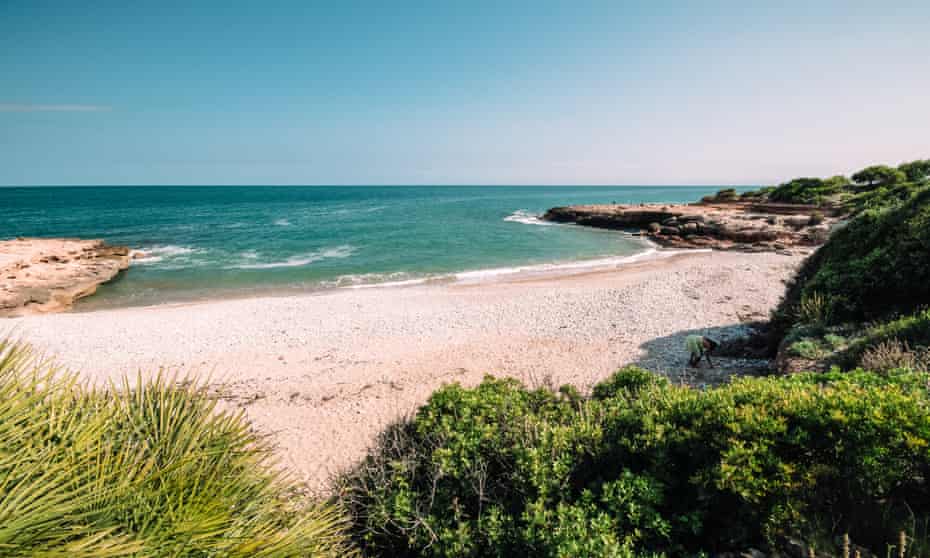
The “orange blossom” coast stretches for 115km between Barcelona and Valencia, offering wild clifftop walks, river beaches and nature reserves home to birds including kestrels and great cormorants and Bonelli’s eagle. Cala Puerto Negro is a small pebble cove in the Serra d’Irta natural park, a marine reserve with a succession of cute beaches surrounded by dwarf palms, mastic trees and sea rocket. The coastal path further south-west is ideal for hikers and mountain bikers.
Where to stay
Camping Ribamar (pitch from €37, bungalow from €90) is a 45-minute drive through the park along the coast.
Where to eat
Cocina Pura Vida, 3.7km south-west of Alcossebre, is anorganic seafront restaurant serving innovative food and lactose free ice-cream.
Es Portitxol, Ibiza
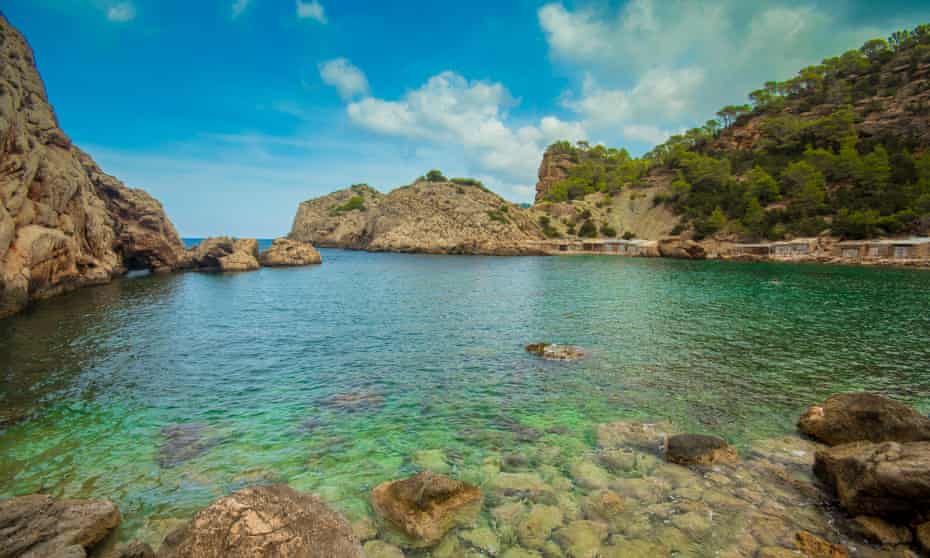
On Ibiza, coastal paths lead to astonishing secret coves with rich marine ecosystems. Es Portitxol is a perfect example: a circular bay on the north of the island a half-hour hike signposted from the road north off Urbanización Isla Blanca along a scenic cliffside trail. Wear suitable shoes and bring supplies. With lots of places to jump and dive from rocks into the sea, the turquoise waters offer some of the best swimming on the island. The shore is lined with traditional fishing huts still used by fishers. Water shoes are also recommended for swimming off the pebbly beach.
Where to stay
Agroturismo Can Jaume (doubles from €250 B&B) half an hour’s drive south, is a stylish place that grows most of its own produce, so expect incredible breakfasts, particularly for vegans and vegetarians. Agroturismo Can Domo (doubles from €150 B&B) half an hour’s drive south-east, has rustic rooms, a pretty pool and a great restaurant.
Where to eat For spectacular views, well-earned post-adventure refreshments and freshly made pizza, head to Boathouse Bar at the bottom of Carrer Sn81, the main road to Urbanización Isla Blanca.
Hidden Beaches Spain: 450 secret coast and island beaches to walk, swim & explore, by Lola Culsán and John Weller is out now (Wild Things Publishing, £18.99). Guardian readers can get 20% off and free P&P with code GuardianSpain21





